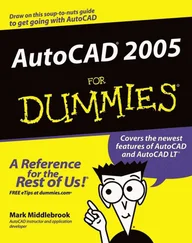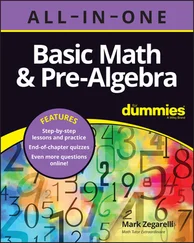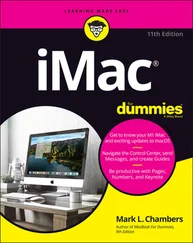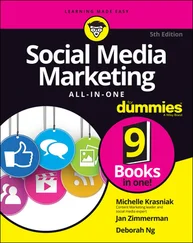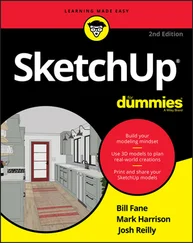383 387
384 388
385 389
386 391
387 392
388 393
389 394
390 395
391 396
392 397
393 399
394 400
395 401
396 402
397 403
398 404
399 405
400 406
401 407
402 408
403 409
404 410
405 411
406 412
407 413
408 414
409 415
410 417
411 418
412 419
Laptop owners are special people.
You see, a laptop owner demands everything from a computer that a desktop owner does: reliability, performance, expandability, and ease of use. Owners of Mac Pro, Mac mini, iMac, and iMac Pro desktop computers can draw the line right there, because their computers are designed for a stationary existence. But you and I are laptop owners. We also need that same computer to be an inch thick (or less). We demand that it run for hours on a single battery charge. We require that it be light as a feather. We want to conquer the coffee shop, the library, and even a lecture hall or two!
Today’s Apple laptops deliver all that and more. If you’ve bought one of these modern masterpieces — or you’re thinking about it — I applaud your good taste, common sense, and discerning eye. Apple laptops have everything: super performance; a top-shelf LED screen; rugged reliability; and a trouble-free, powerful operating system. Heck, your Intel-based Apple laptop can even run — wait for it — Windows 10. (If you absolutely have to, the option is there.)
I wrote this book for myself — and for every other Apple laptop owner who wants to become a laptop technowizard. In these pages, you find a guide to both your laptop’s hardware and macOS Big Sur, the latest version of Apple’s superb operating system. After I cover the basics that every laptop owner should know, you find out how to accomplish all sorts of cutting-edge audio, visual, and Internet projects. (Oh, and if you already have another of my books, you know that I don’t skimp on the power-user tips and tricks that save you time, effort, and money.)
So who is the target audience for this book? As in past editions, I make no assumptions about your previous knowledge of computers and software. I figure that you’ve just bought a MacBook or are considering buying one. Perhaps you’ve found a bargain on a gently used older MacBook, and you need guidance as you learn the ropes. Those are the only assumptions I make. And unlike other books that require a lot of technical expertise to understand, this book’s only requirement is your desire to become a Mac laptop power user (someone who produces the best work in the least amount of time and has the most fun doing it)!
 By the way, if your friends and family predicted that you’ll spend half your life savings on software — or that no “decent” software is available for Mac computers — just smile quietly to yourself! The MacBook comes complete with more productivity software than any Windows box, and this software is better than anything available on a PC!
By the way, if your friends and family predicted that you’ll spend half your life savings on software — or that no “decent” software is available for Mac computers — just smile quietly to yourself! The MacBook comes complete with more productivity software than any Windows box, and this software is better than anything available on a PC!
 This book was written on one of the latest Intel quad-core MacBook Air models. Because of changing hardware, owners of older Mac laptops may not be able to follow along with every feature I cover. If you’ve upgraded an older MacBook to macOS Big Sur, however, you should be able to use most of this book with no problem.
This book was written on one of the latest Intel quad-core MacBook Air models. Because of changing hardware, owners of older Mac laptops may not be able to follow along with every feature I cover. If you’ve upgraded an older MacBook to macOS Big Sur, however, you should be able to use most of this book with no problem.
In writing about the MacBook, I’ve kept one precept firmly in mind: macOS Big Sur, the operating system you’ll run, is just as important as the laptop itself. Therefore, you’ll find that MacBook For Dummies, 9th Edition is just as much about familiarizing you with all the software you get as it is with introducing hardware features such as the Touch Bar, the keyboard, and the trackpad. After all, it’s relatively easy to connect a power cable and turn on any new computer. What comes next is the challenging part!
As in my other For Dummies titles, I respect and use the same everyday language you do, avoiding jargon, ridiculous computer acronyms, and confusing technobabble whenever possible.
If you’re upgrading from a PC running the Windows operating system, I’ve got tips, tricks, and entire sections devoted to those hardy pioneers called Switchers. You discover both the similarities and differences between your MacBook running Big Sur and a PC running Windows. I also show you how to make the switch as easily and quickly as possible.
A word about the conventions I use: Even with an absolute minimum amount of technospeak, this book needs to cover the keys you have to press or menu commands you have to choose to make things work. Therefore, please keep in mind this short list of conventions as you read:
Stuff you type: If I ask you to type (or enter) something, such as in a text box or field, that text appears in bold, like this: Type me.You usually have to press Return before anything happens.
Menu commands: I list menu paths and commands by using another format. This instruction indicates that you should click the Edit menu and then choose the Copy menu item:Edit ⇒ Copy
Web addresses: No up-to-date book on a computer would be complete without a bag full of web addresses for you to check out. When you see these in the text, they look like this: www.mlcbooks.com . (By the way, that website does exist. You’re always welcome to check out my little acre of Internet space!)
For the technically curious: Your MacBook is an elegant and sophisticated machine, and it’s as easy to use as a computer can be. But from time to time, you may be curious about the technical details that surround your hardware and software. (Perhaps you disassembled alarm clocks as a kid, as I did.) Techie stuff is denoted with a margin icon, as discussed in the next section. You don’t have to read the technical notes unless you want to know what makes things tick. (Pun by sheer accident.)
Like other technology authors, I firmly believe that important nuggets of wisdom should stand out on the page! With that in mind, this For Dummies book includes margin icons for certain situations:
 This icon is the most popular icon in the book. You find it parked next to suggestions I make to save you time and effort (and even cash!).
This icon is the most popular icon in the book. You find it parked next to suggestions I make to save you time and effort (and even cash!).
 You don’t have to know this information, but the technologically curious love high-tech details. (We’re great fun at parties, too.)
You don’t have to know this information, but the technologically curious love high-tech details. (We’re great fun at parties, too.)
 Always read this information before you take action!I’m discussing something that could harm your hardware or throw a plumber’s helper into your software.
Always read this information before you take action!I’m discussing something that could harm your hardware or throw a plumber’s helper into your software.
 Consider these nuggets to be highlighter stuff — not quite as universally accepted (or as important to the author) as a Mark’s Maxim (described next), but good reminders nonetheless. I use this icon to reinforce what you should remember.
Consider these nuggets to be highlighter stuff — not quite as universally accepted (or as important to the author) as a Mark’s Maxim (described next), but good reminders nonetheless. I use this icon to reinforce what you should remember.
Читать дальше
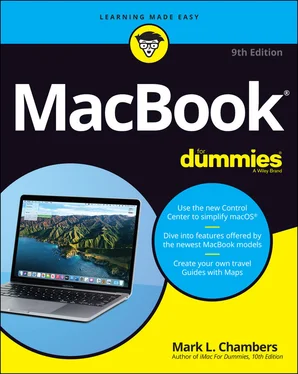
 By the way, if your friends and family predicted that you’ll spend half your life savings on software — or that no “decent” software is available for Mac computers — just smile quietly to yourself! The MacBook comes complete with more productivity software than any Windows box, and this software is better than anything available on a PC!
By the way, if your friends and family predicted that you’ll spend half your life savings on software — or that no “decent” software is available for Mac computers — just smile quietly to yourself! The MacBook comes complete with more productivity software than any Windows box, and this software is better than anything available on a PC! This book was written on one of the latest Intel quad-core MacBook Air models. Because of changing hardware, owners of older Mac laptops may not be able to follow along with every feature I cover. If you’ve upgraded an older MacBook to macOS Big Sur, however, you should be able to use most of this book with no problem.
This book was written on one of the latest Intel quad-core MacBook Air models. Because of changing hardware, owners of older Mac laptops may not be able to follow along with every feature I cover. If you’ve upgraded an older MacBook to macOS Big Sur, however, you should be able to use most of this book with no problem. You don’t have to know this information, but the technologically curious love high-tech details. (We’re great fun at parties, too.)
You don’t have to know this information, but the technologically curious love high-tech details. (We’re great fun at parties, too.) Always read this information before you take action!I’m discussing something that could harm your hardware or throw a plumber’s helper into your software.
Always read this information before you take action!I’m discussing something that could harm your hardware or throw a plumber’s helper into your software.